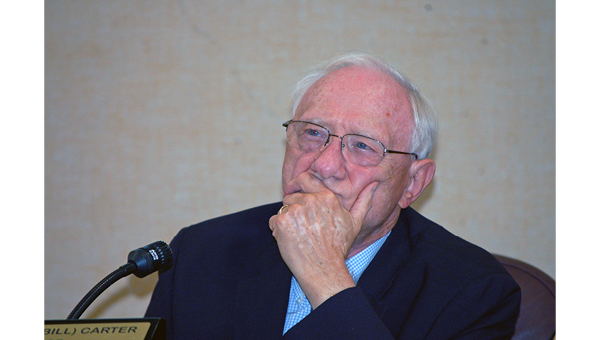Council eyes 11th straight rate hike
Published 10:03 am Friday, April 17, 2015
“The chickens have come home to roost.”
Trending
That was Elizabethton Utilities Director Johann Coetzee proclamation after telling City Council water and sewer rates would need to be raised for what Mayor Curt Alexander says is the 11th year in a row. A proposed $4 increase in the base water rate, a $3 increase to the base sewer rate and 4 percent annual increases in both water and sewer usage rates are include in the 2015-16 budget.
For the current fiscal year, the city water and sewer is projected to have an $823,559 shortfall in revenue because the water and sewer rates have been “under-collected,” Coetzee said. The expected combined revenue for the two utilities was $8,238,889. The projected actual revenue is $7,415,330, which is 10 percent less that what was projected.
“This year, we are going to go in the negative on our income,” he said. “If we do that two years in a row, we will have to go to a show cause hearing in Nashville. The state will take over and do a rate change for us.”
The current water rates for customers inside the city limits are a base minimum of $14.95 for the first 1,000 gallons. The charge is then $4.01 for each 1,000 gallons up to 499,999; $2.57 per 1,000 gallons from 500,000 to one million gallons and $2.47 per 1,000 gallons for usage over one million. The proposed change is close to a 30 percent increase on the current rates.
For customers outside the city limits, the current minimum is $21.84 with additional charged of $7.07 per 1,000 gallons from 1,000 to 499,000; $4.43 per thousand gallons from 500,000 to one million gallons and $4.15 for each thousand gallons over one million.
Sewer rates are at $12.66 for the minimum bill and then $3 per thousand gallons for customers inside the city. Outside customers are charged a minimum of $16.77 and $5.60 per 1,000 gallons up to 9,000 and then $4.08 per 1,000 gallons over 9,000.
Trending
The current water and sewer rates were determined during last year’s budget cycle by a study completed by engineering firm McGill and Associates. At the time, the study declared the current rate structure would be sufficient to support the utilities operations and infrastructure needs. However, the amount collected was not as high as predicted, leading to the shortfall.
Over the past three years, the revenue collection has decreased by 5 percent, 3 percent and 4 percent respectively for a total decrease of 11.5 percent on the total revenues.
There were multiple reasons for the under collection, Coetzee said. One was reduced use from customers after the previous rate increases along with natural decreased use because of the seasons. The biggest impact came from more water efficient fixtures and appliances in homes.
Some council members expressed their frustrations that the study was off the mark and that the same firm was brought back to do the study again.
“It is quite frustrating to pay a firm to do a study and then the information is not accurate,” councilman Richard Tester said. “They still get compensated and then we bring them back again and work with them again.”
For the first study that was completed last year, the city paid $15,000 for the consulting services by McGill and Associates. For the revisit this year, the cost is expected to come in at around $10,000.
Alexander questioned how the study done last year could have missed the revenue collection by 10 percent.
“Last year, we talked about what we needed to do and why it was crucial to raise the rates again,” Alexander said. “We hired a firm to tell us what we needed to do, and it was missed by 10 percent. Now we hired the same firm. How can we have the confidence they will get it right this time? If they miss by 10 percent again we are really in trouble.”
The study needed to be recalibrated to include the new information that has been collected this year, and to include the continued reduction in use because of water efficient appliances, Coetzee said. The same firm was chosen again, he said, because they were a “firm of integrity” and already had all the information from the first study which made the adjustments easier.
“We were surprised by the results,” Eric Goodman, project manager, said. “We did put a lot of work into the study and were alarmed by the realization we were under collecting about six months into the year. We did not make the model sensitive enough to compound that decrease. That was something we can recalibrate and make the model predict that. We wanted to make the first study fair, so that we were not over-charging customers if it was wrong.”
Councilman Bob Cable questioned if the results meant that all the money had not been collected, or if the rates had not been high enough to cover the costs of the water department. Coetzee told him the rates had been lower than what was needed to sustain the utility.
“So what you are saying is that we were not charging our customers enough,” Cable said.
Alexander wanted to know how the past rate increases over the past 11 years were not enough to meet the of the department and asked if there were any expenses that could be cut instead of another substantial increase.
“Every year for the past 11 years we have raised water rates,” Alexander said. “We are throwing money at a problem and that doesn’t fix it all the time. I cannot in good conscious vote for an increase of this size. It will come to a point where people can’t afford it anymore. It will be the difference between paying their water bill and getting their medicine.”
Enough cuts could not be made to make up the difference of what was needed, Coetzee said.
“There is no room in the cost structure to cut expenses to meet the difference and repair our infrastructure,” Coetzee said. “I cannot save enough to fix this.”
In addition to covering the difference, the rate increases would also allow for future infrastructure improvements to the water and sewer systems.
“We need to think about what we are handing off to the future generations of our community,” Coetzee said.
Council will meet in another workshop May 12 to further discuss the budget and the possible rate increases.






